What Is Marketing Attribution?
Marketing attribution is the process of determining which marketing actions help drive leads or sales.
It takes into account all the customer touchpoints between learning about a brand and converting to a customer.
The Importance of Marketing Attribution in Digital Marketing
Marketing attribution allows businesses to:
- Identify the best-performing marketing channels: Find out which marketing channels are driving the most customers to your business. And which ones are underperforming.
- Get a better understanding of the customer journey: Learn more about all the different touchpoints involved in getting a new customer.
- Improve return on investment: Stop wasting your marketing budget on under-performing channels. And double-down on your top performers.
- Get stakeholder buy-in: Use marketing attribution data to prove the effectiveness of specific marketing channels. And get stakeholder buy-in to increase investment in the most effective channels.
Types of Marketing Attribution Models
There are different ways of attributing sales to specific marketing channels. And they’re collectively referred to as attribution models.
The two main groups of attribution models are single-touch and multi-touch.
Single-touch attribution models give all the credit for a sale to one specific touchpoint or channel (usually the first or last one).
Multi-touch attribution models credit all touchpoints or channels that contributed to a sale. Let’s compare some of the most popular single and multi-touch attribution models:
First-Touch Attribution Model
The first-touch attribution model gives all the credit for a sale to the first touchpoint the customer had with your brand. Such as a click on your social media post. Or a click on your ad in search results.
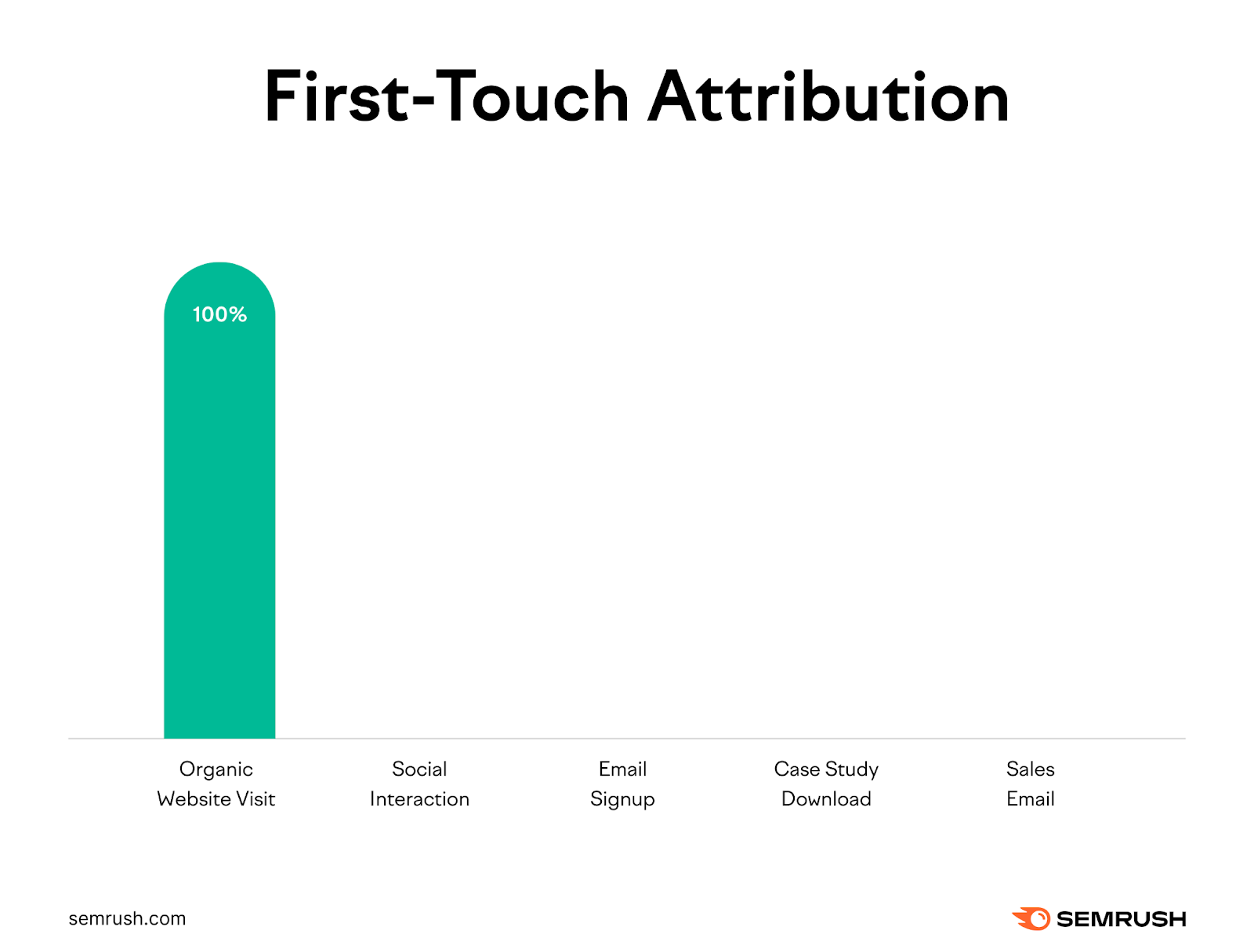
While this attribution model is simple to implement, it often doesn’t provide the full picture.
A customer might have had a dozen interactions with your brand after the first interaction. For example, they might have read your blog content for a few weeks after initially discovering you through social media. And signed up for your email newsletter.
Then, they might have read a couple of your emails and finally converted after clicking on a link in one of them.
If you use first-touch attribution, all the credit for this sale will go to your social media campaign. Even though other channels (like email) might have played a bigger part in landing the sale.
This could lead to wasted marketing dollars investing in social media. When investing in email marketing may lead to a higher ROI.
Last-Touch Attribution Model
With the last-touch attribution model, all the credit for a conversion goes to the last touchpoint the customer had with your brand before making a purchase.
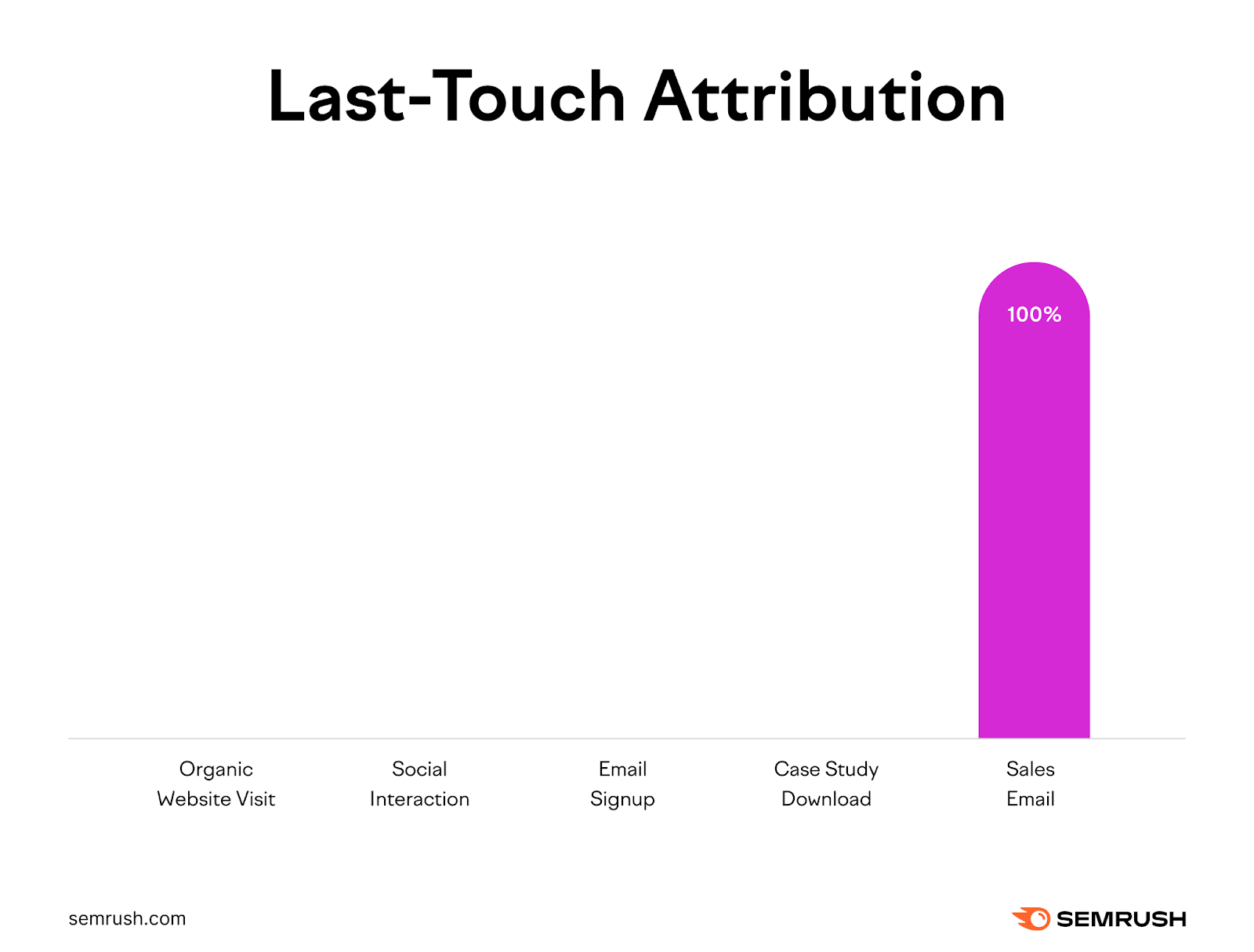
For example, a customer might have:
- Seen your billboard ad on their way to work for the past month
- Watched your brand’s Instagram stories for weeks
- Read your blog content for years
But then, they click on your ad in Google search results and convert. With last-touch attribution, all the credit for the sale would go to your Google Ads campaign.
Similarly to first-touch attribution, this attribution model is fairly simple to implement. But it suffers from the same downside—its simplicity can lead to you making the wrong judgment on the effectiveness of specific marketing channels.
Linear Attribution Model
Linear attribution is a multi-touch attribution model. It takes into account all the different touchpoints a customer has with your brand before making a purchase. And gives them all equal credit for a sale.
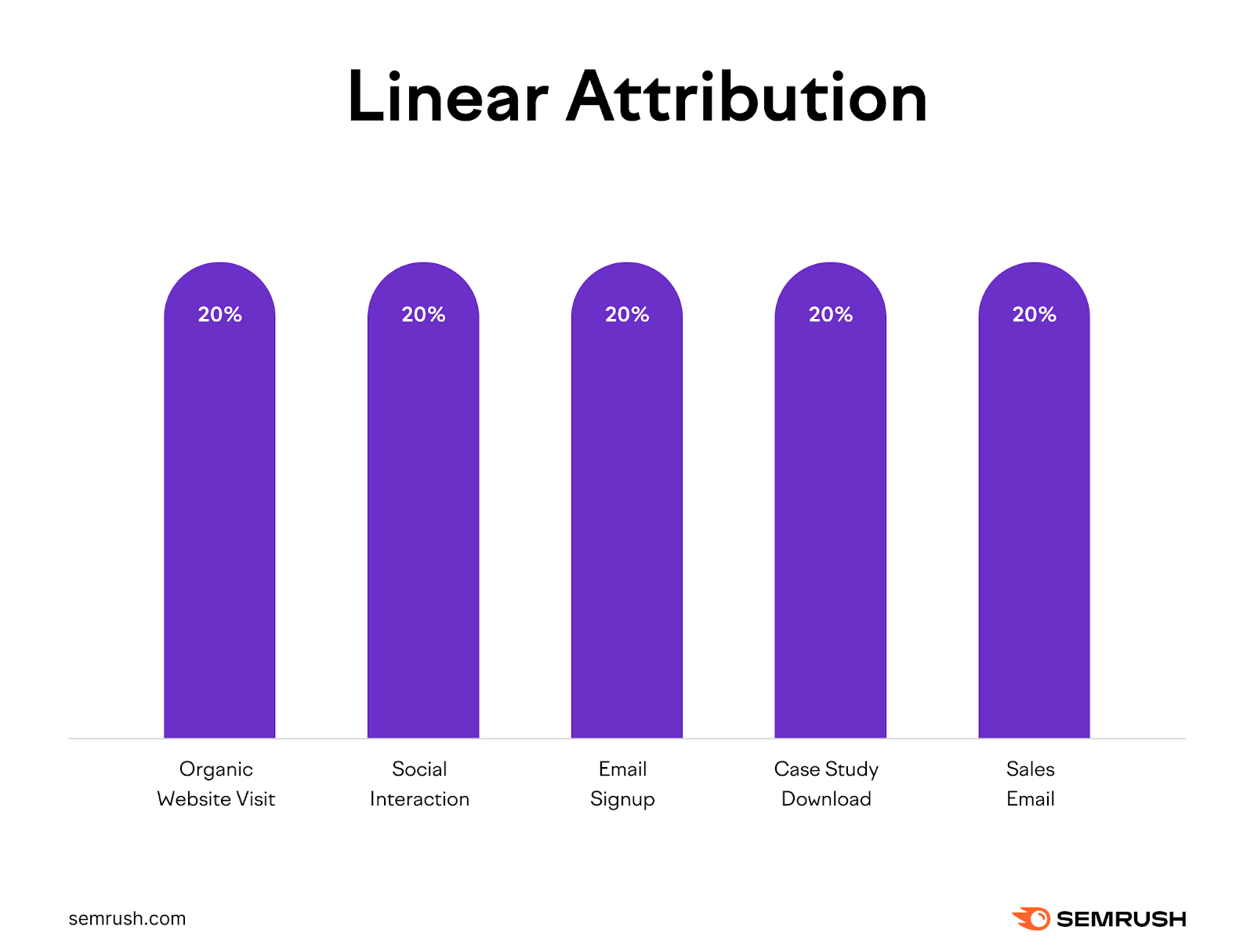
This gives you a more complete picture of all the touchpoints involved with conversions. And can help you avoid overestimating the effectiveness of any single channel.
But the linear attribution model has its own disadvantages. For one, it can be more difficult to implement compared to first-touch or last-touch attribution. As you need to monitor more touchpoints in greater detail.
Also, depending on the customer journey for your specific business, all touchpoints having equal weight might be unrealistic.
For example, a customer might have read ten articles on your blog and interacted with dozens of your social media posts. Then, they might have opened a single email newsletter from your brand and converted.
In this case, while it’s useful to know that all three channels contributed to the sale, saying that they all contributed equally to the sale might not be accurate.
Time Decay Attribution Model
With the time decay attribution model, multiple touchpoints are weighted differently. This model assumes that later touchpoints have a greater influence on driving the customer to make a purchase.
The last touchpoint gets the most credit. While the first touchpoint gets the least amount of credit for the sale.
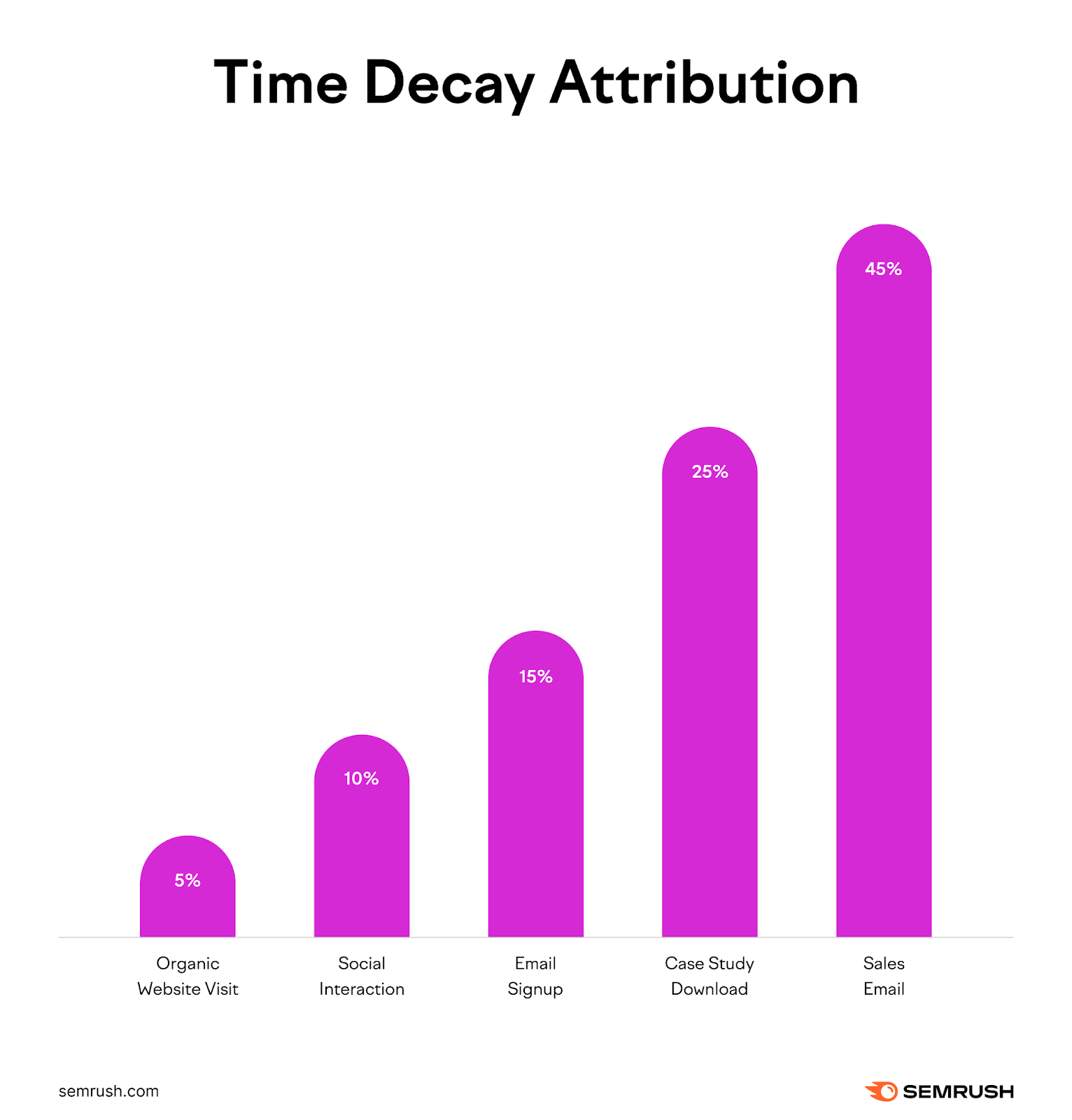
The downside of this model is that it can undervalue top-of-the-funnel marketing efforts.
Here’s an example:
During a product launch, you might spend a considerable percentage of your marketing budget on traditional media advertising, social media marketing, and influencer collaborations to raise brand awareness and get people to learn about your product.
This can help your pay-per-click (PPC) ads generate better click-through rates and ultimately convert at a higher rate. Because people have seen your brand in lots of places and therefore trust your ads more than others.
Using time decay attribution, your PPC ads would get the most credit for the sale. While your initial brand awareness efforts would get the least amount of credit, even though they might have had a significant impact on sales.
U-Shaped (Position-Based) Attribution Model
The U-shaped attribution model is a multi-touch attribution model that credits touchpoints as follows:
- 40% of the credit goes to the first touchpoint
- 40% of the credit goes to the last touchpoint
- 20% of the credit goes to all the remaining touchpoints
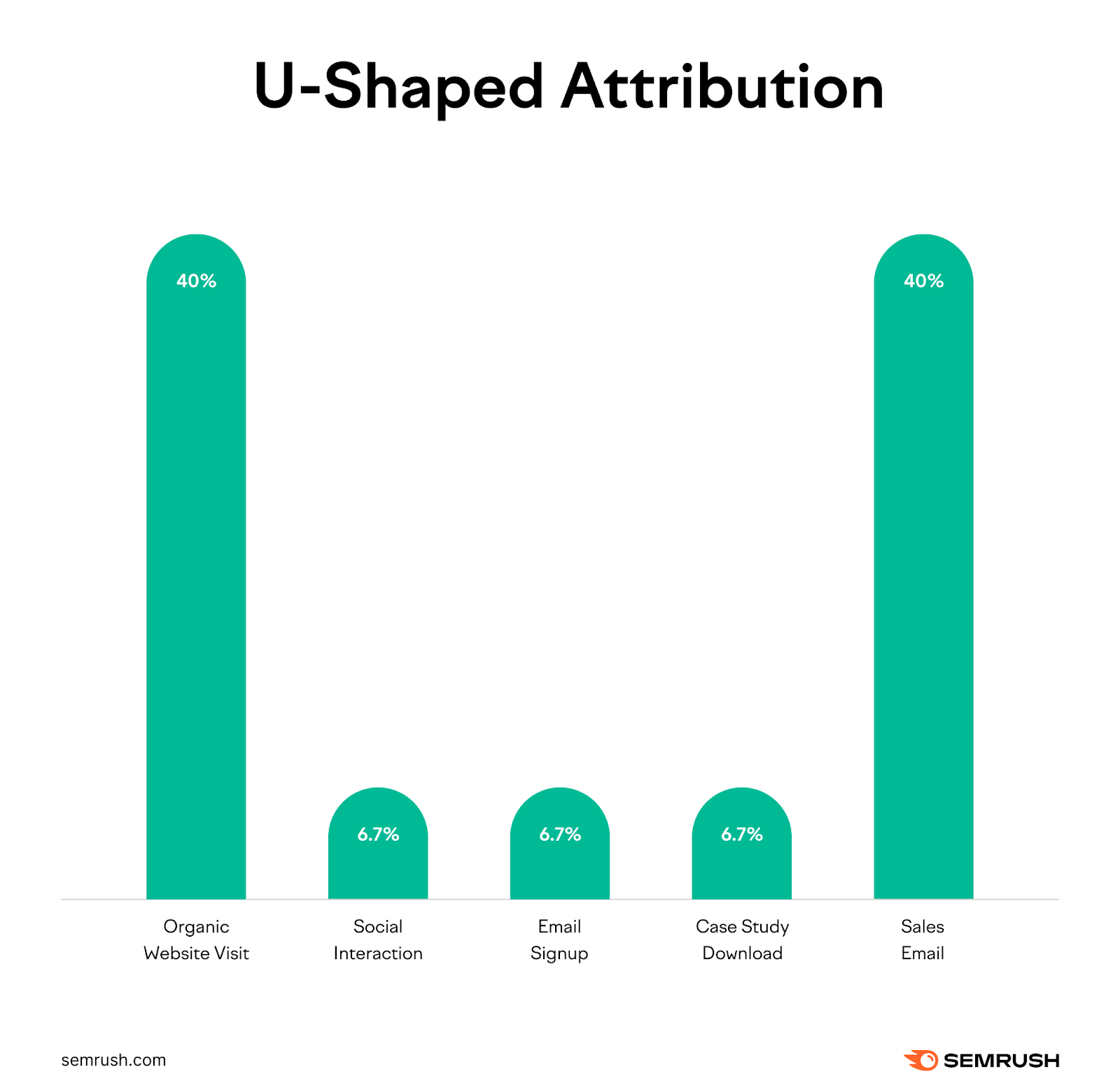
It makes the assumption that the first and last touchpoints are the most impactful for driving a customer to make a purchase. But this might not be the case for your specific business.
W-Shaped Attribution Model
The W-shaped attribution model gives 3o% credit each to:
- The first touchpoint
- The mid-funnel touchpoint
- The last touchpoint
The remaining 10% is split evenly across all the remaining touchpoints.
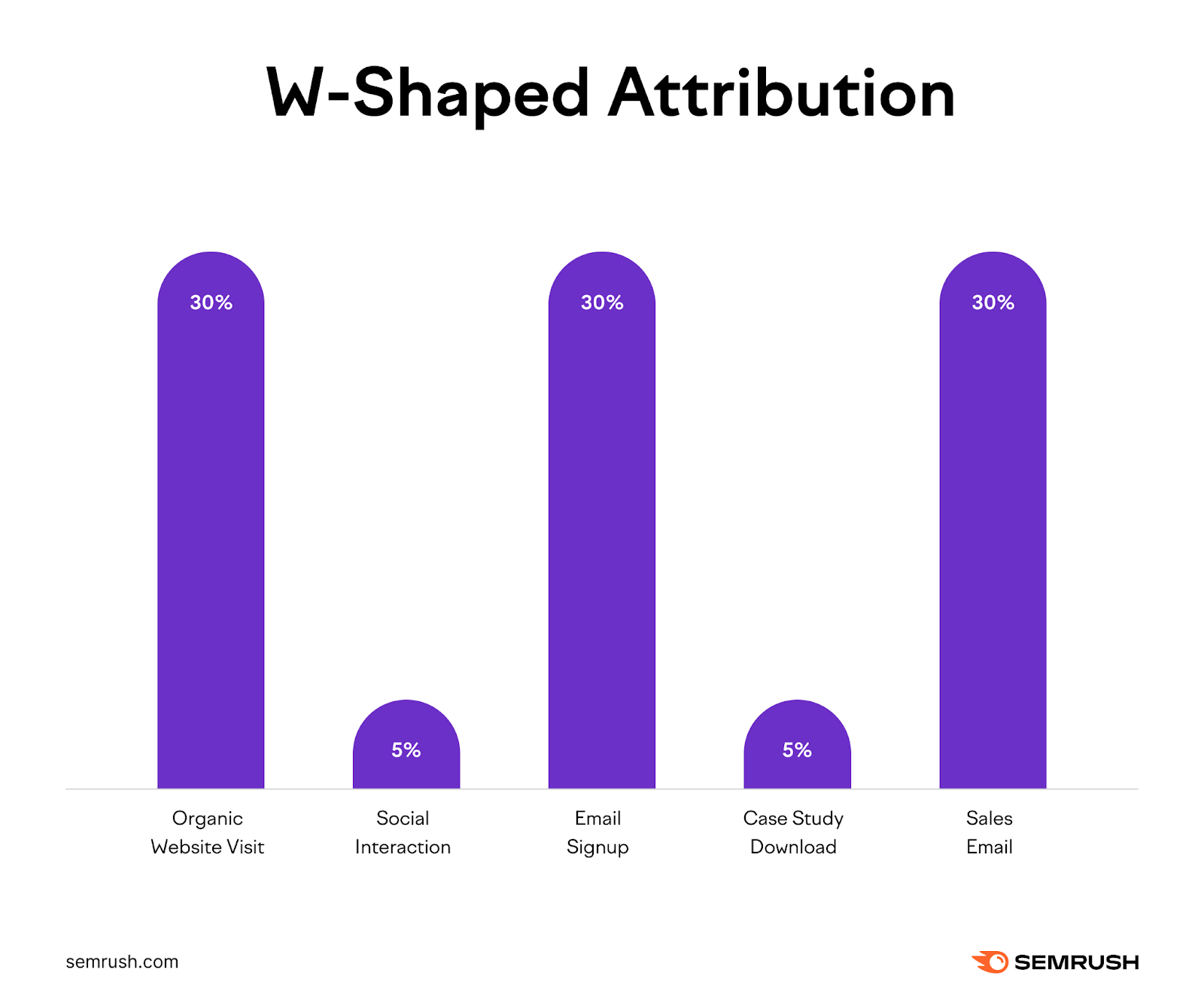
How to Pick a Marketing Attribution Model
Picking the right marketing attribution model ensures you have accurate data to allocate your marketing budget effectively. Consider the following when choosing an attribution model for your business:
Your Goal
What are you trying to measure?
Are you looking to find out which marketing channel brings in the most leads? Or which one drives the most revenue?
In the first case, you might opt for first-touch attribution. In the latter, last-touch attribution might make more sense.
Sales Cycle Length
How long is your business’s sales cycle? A B2B business with a 6-month sales cycle will benefit from a different attribution model compared to a B2C business with a relatively short sales cycle. And the complexity of the sales cycle matters too.

For example, a B2B business might opt for the linear marketing attribution model to track all the different touchpoints that influence a sale.
While first-touch or last-touch attribution might make more sense for a B2C business. Where the sales cycle is short and the first and last touches generally have more weight. A U-shaped attribution model could also work well.
Customer Journey
What does the customer journey for your business look like? What’s the average number of touchpoints, and how are they spread out?
If the average sale for your business involves a lot of different touchpoints that could convert, linear marketing attribution would be appropriate.
If the customer journey is long, with lots of nurturing involved before they’ll convert, a time decay attribution model could be the right choice.
Or imagine a business where the average sale only involves a few touchpoints that are likely to convert. In this case, a U-shaped or W-shaped attribution model might be best. Or even a customized model.
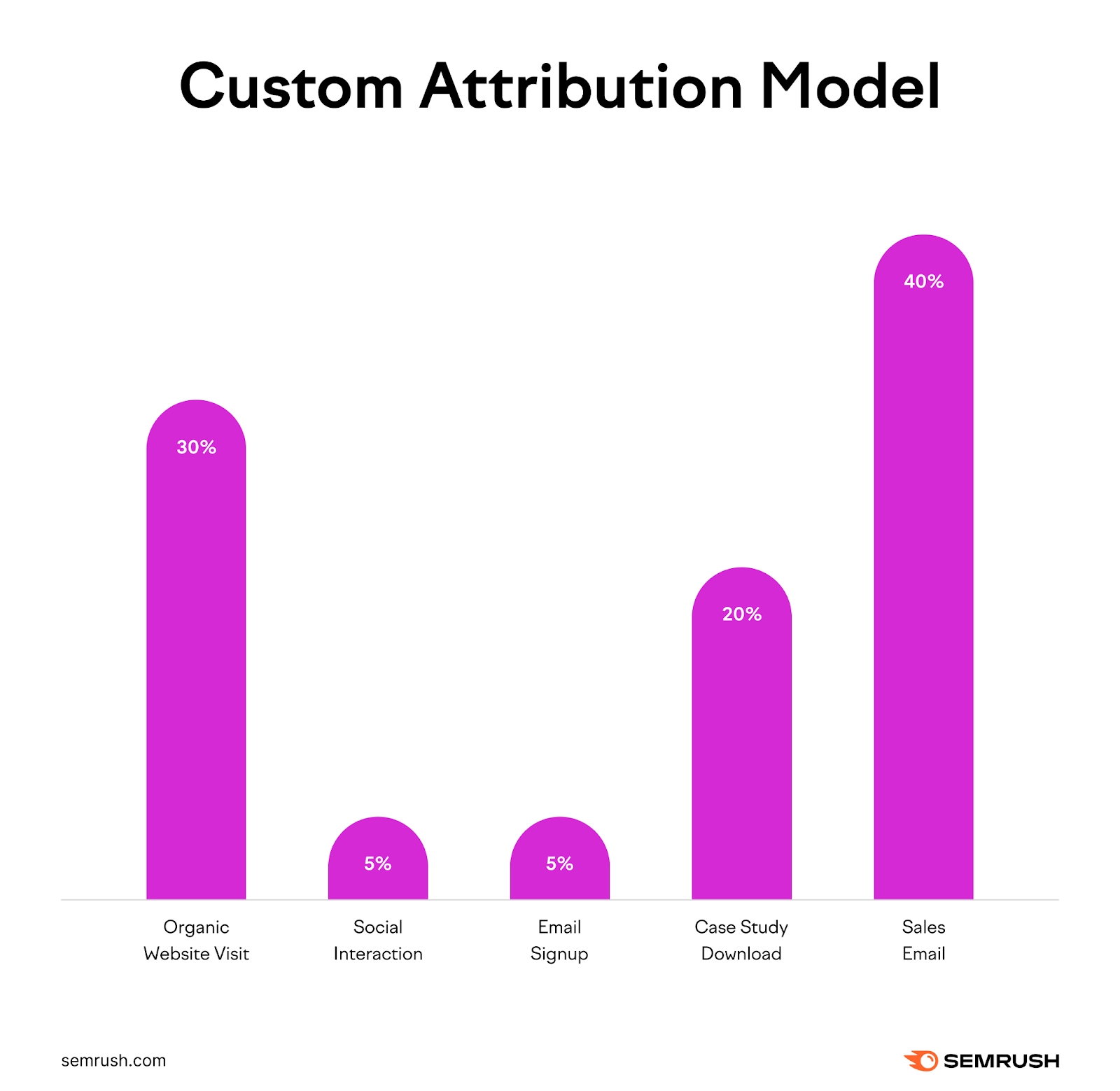
How to Implement Marketing Attribution
Now that you’ve decided on an attribution model for your business, let’s look at how to implement wider aspects of marketing attribution.
Choose the Right Marketing Attribution Tool
You’ll need specialized software to attribute conversions to specific marketing channels. We’ll cover some tools to use in the next section. But first, you need to know the features you should be looking out for.
Here are the most important aspects to consider:
- Ease of use: You don’t want to waste hours learning how to use the tool. Or training your team on how to use it.
- Integrations: Any marketing attribution tool you decide to use should integrate with your existing tech stack.
- Customer support: You’ll use these tools to help allocate your marketing budget, so continuous and proper functionality are key. Look for a tool that offers prompt customer support to quickly resolve any issues.
Integrate Marketing Attribution into Your Wider Strategy
In order to be effective, you need to integrate attribution into your wider marketing strategy. This involves:
Aligning Attribution with Business Goals
The way you approach marketing attribution needs to align with your business goals. To achieve this, you’ll need to:
- Determine your business goals
- Assign key performance indicators for each goal
- Choose an appropriate attribution model based on your goals
Training Your Team on Attribution Concepts
To get the most out of your marketing attribution data, you need to train your team on the specific marketing attribution model your business uses. And any tools you use.
Analyze Your Data & Optimize Your Strategy
Depending on the marketing attribution software you use, there will be multiple different types of attribution reports available to you. Here’s an example of a traffic source report in Google Analytics:
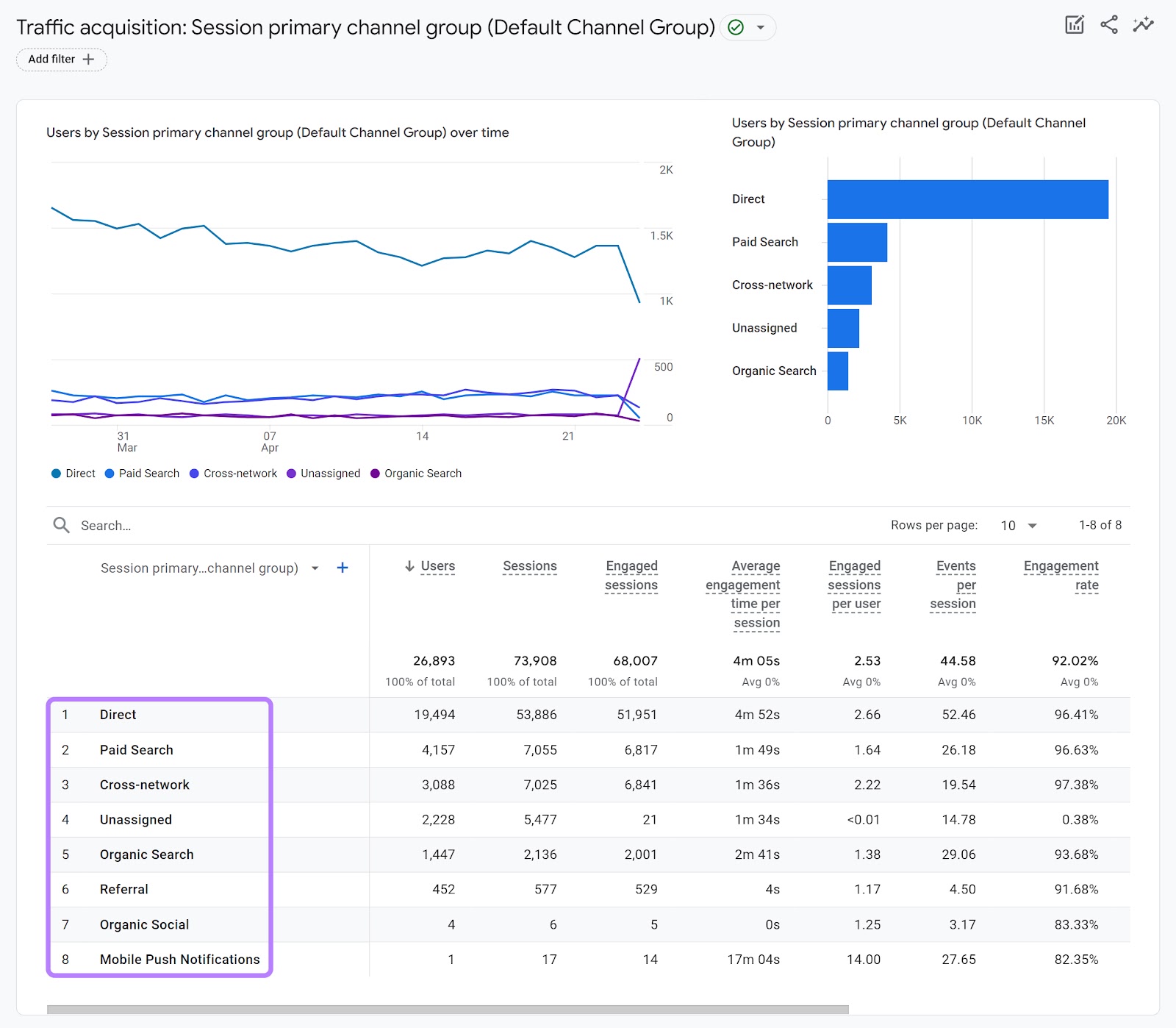
This data is useful for understanding which platforms and campaigns are driving traffic to your website.
Here are a few questions marketing attribution reports can help you answer:
- What does the average conversion path look like? Reports can reveal the exact steps customers take before making a purchase. You can then use this information to optimize specific steps in the process.
- How does the effectiveness of specific marketing channels change over time? You can use attribution reports to understand trends and market shifts. And adjust your marketing efforts accordingly.
- How do different groups of customers respond to marketing activities? Attribution reports allow you to analyze customer segments to understand how they might differ. This will give you the information you need to create highly personalized marketing campaigns.
- How long does it take for a prospect to turn into a customer? You can use attribution reports to get a better understanding of your sales cycle length. And then devise strategies to shorten it.
Marketing attribution isn’t a one-and-done thing. You should always be looking for ways to improve the way your business handles marketing attribution.
Review your marketing attribution data periodically (such as weekly or monthly) and extract insights. Then, use those insights to improve your marketing strategy and get better results.
Optimize Your Campaigns Based on Attribution Data
Here are a few ways you can optimize your marketing campaigns based on attribution data:
Reallocate Marketing Budget
Use the data from your attribution reports to identify your top-performing marketing channels.
Then, reallocate your marketing budget from your worst-performing channels to your top performers.
For example, you might notice that influencer collaborations are bringing in more revenue than your PPC campaigns. In that case, it might make sense to reallocate some of your PPC budget into influencer campaigns.
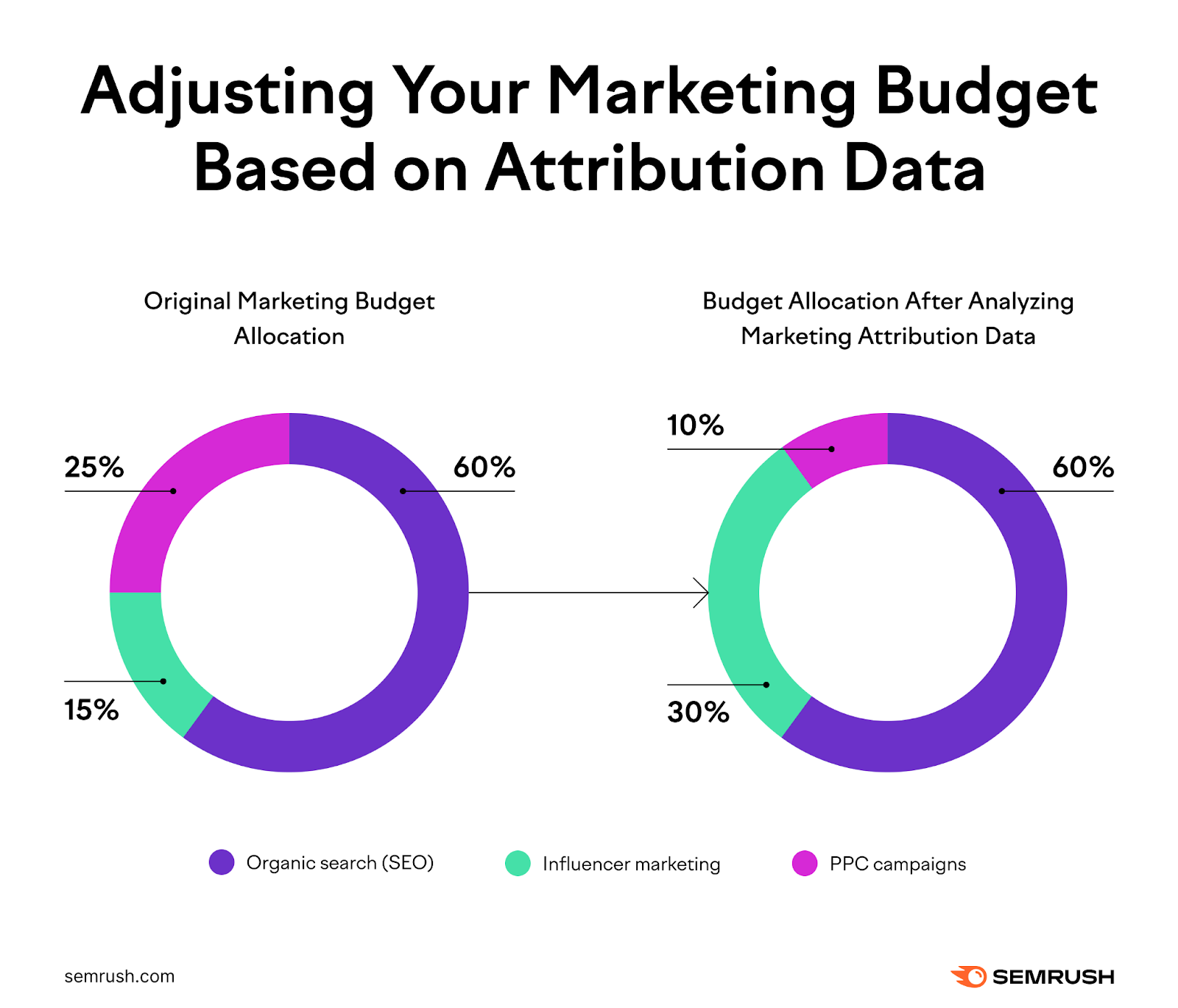
Adjust Targeting
Analyze how different customer segments respond to specific marketing activities and channels.
Then, adjust your targeting to focus on the highest-converting customer segments.
For example, analyzing your marketing attribution reports might reveal that buyers from the agricultural industry tend to convert more often than those in the financial sector.
So it would be wise to focus your marketing campaigns on reaching people in that industry. If you’re running social media advertising campaigns, platforms typically let you adjust your targeting based on this kind of information. Like Facebook:
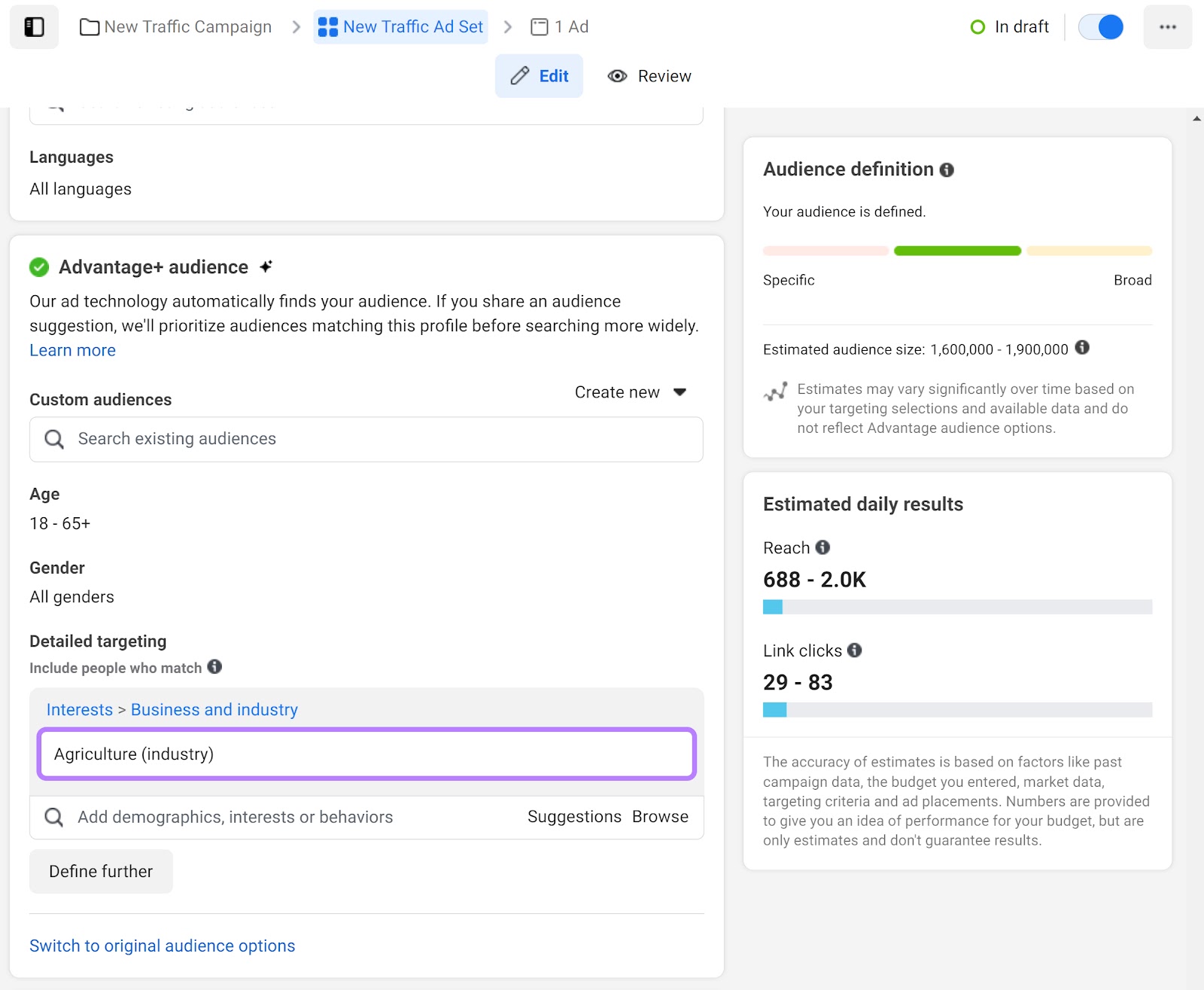
Use Remarketing and Retargeting
Using remarketing and retargeting to enhance the effectiveness of your marketing channels.
Remarketing is when you connect with past customers or those who have already interacted with your business. Typically via email.
But retargeting is used to reach previous site visitors who may not have made a purchase.
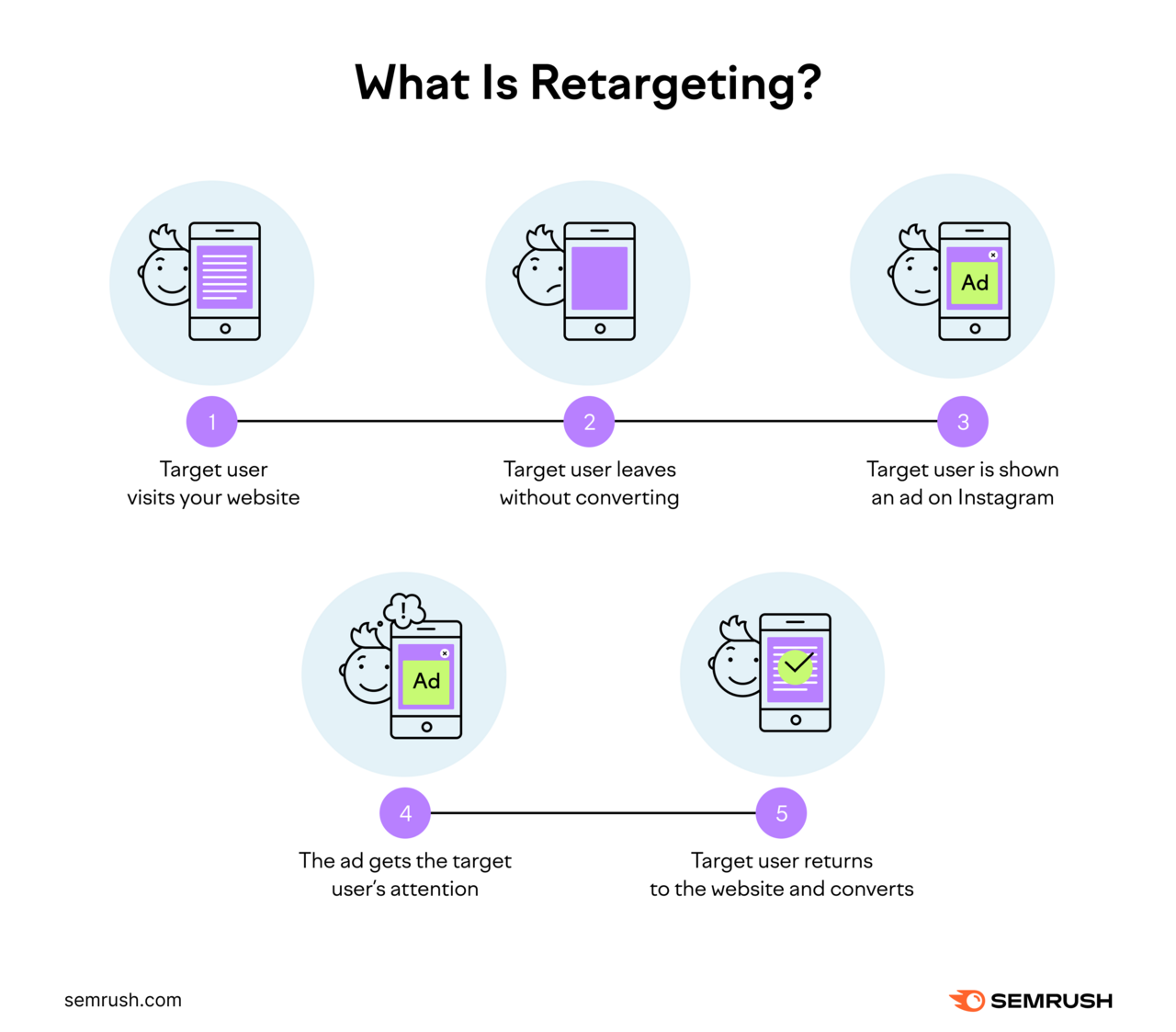
For example, an ecommerce business might use Facebook Ads to retarget shoppers who abandoned their cart. To try to get them to finalize their purchase. This can turn a less important touchpoint into one that plays a key role in getting conversions.
And with remarketing, you can send emails to past customers encouraging them to make more purchases. So, even if email wasn’t an important touchpoint before, your remarketing emails could make it more effective at making sales.
Top Marketing Attribution Tools
Here are five marketing attribution tools to help you better allocate your marketing budget and convert more leads into customers:
1. Organic Traffic Insights
Semrush’s Organic Traffic Insights helps you understand which keywords are driving organic traffic to your website. It combines data from Semrush, Google Analytics, and Google Search Console into a single dashboard.
Apart from the keywords that are driving traffic to your website, Organic Traffic Insights can also show you the total number of sessions each keyword is generating, keyword search volume, and click-through rate.
Here’s how to get started using Organic Traffic Insights:
Enter your domain name and click on “Get Insights.”

You’ll then need to connect your Google account. And select an account, property, and data stream.
Once you’ve done this, click on “Location and Device” at the bottom.
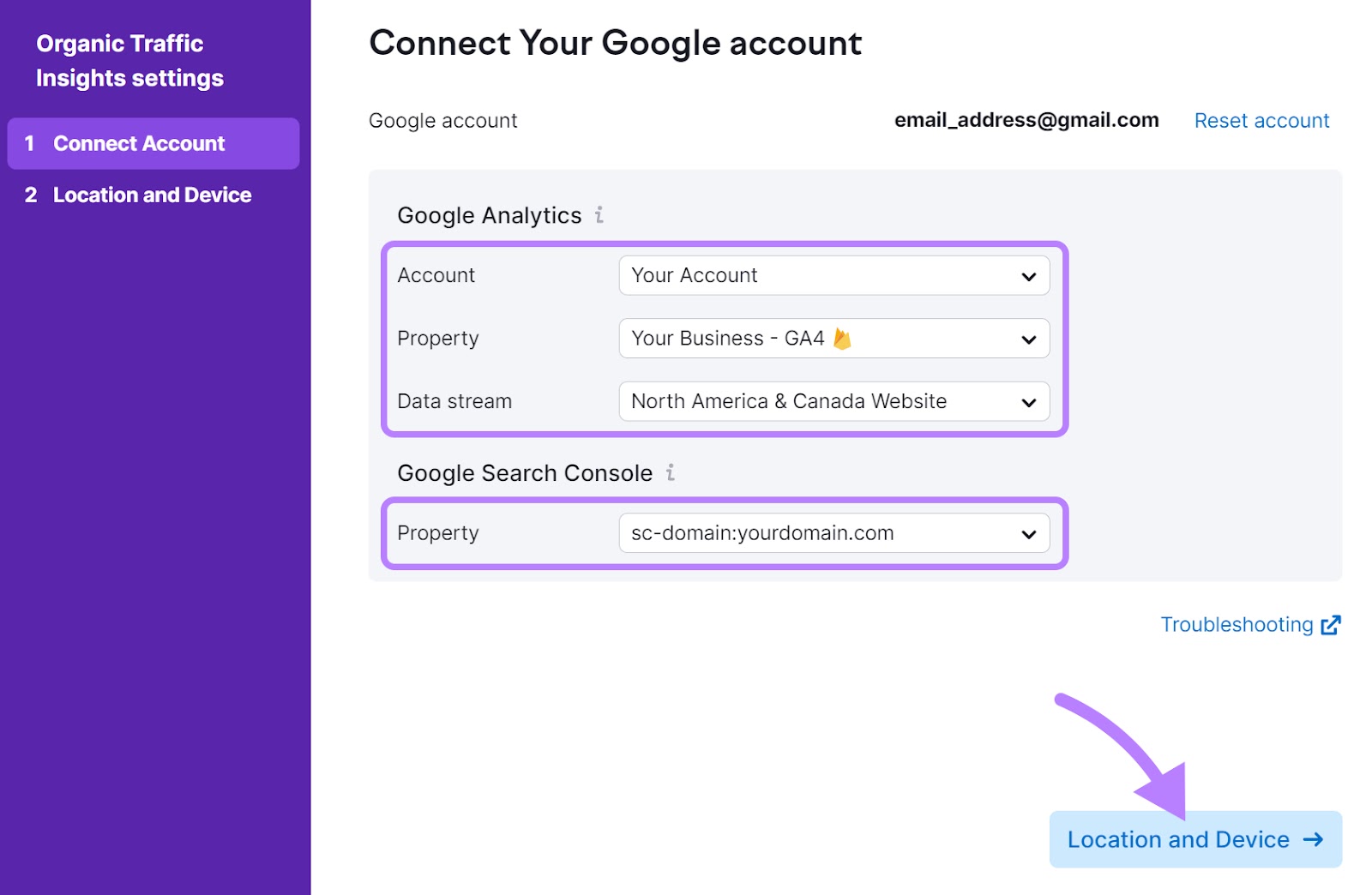
On the next page, you’ll need to select the location and device the data will be shown for. Then click “Go to Organic Traffic Insights.”
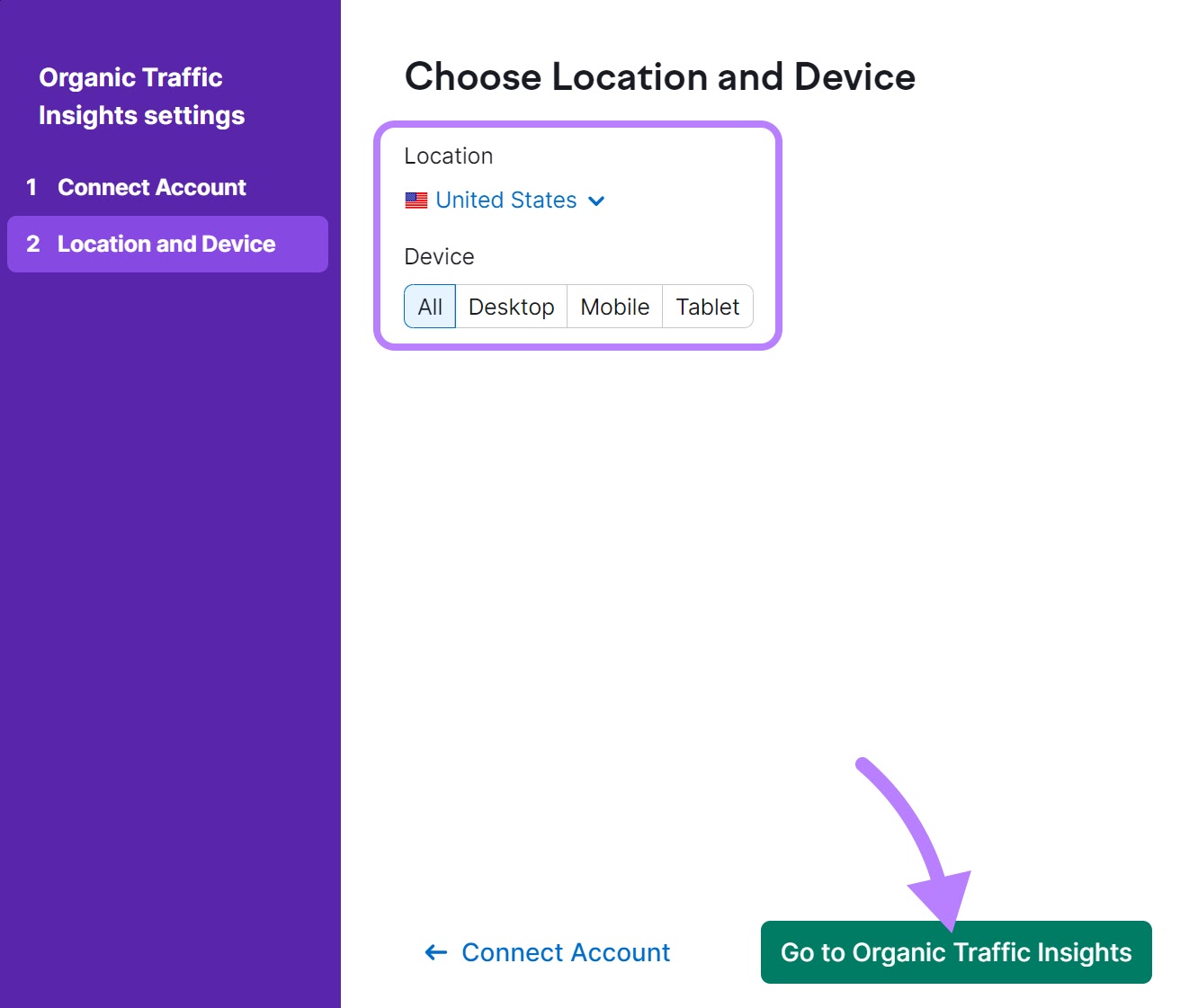
The tool will then present you with a detailed report. Including information on your top-converting pages along with engagement metrics. To see more keyword data for each page, click the number in the “Semrush” column.
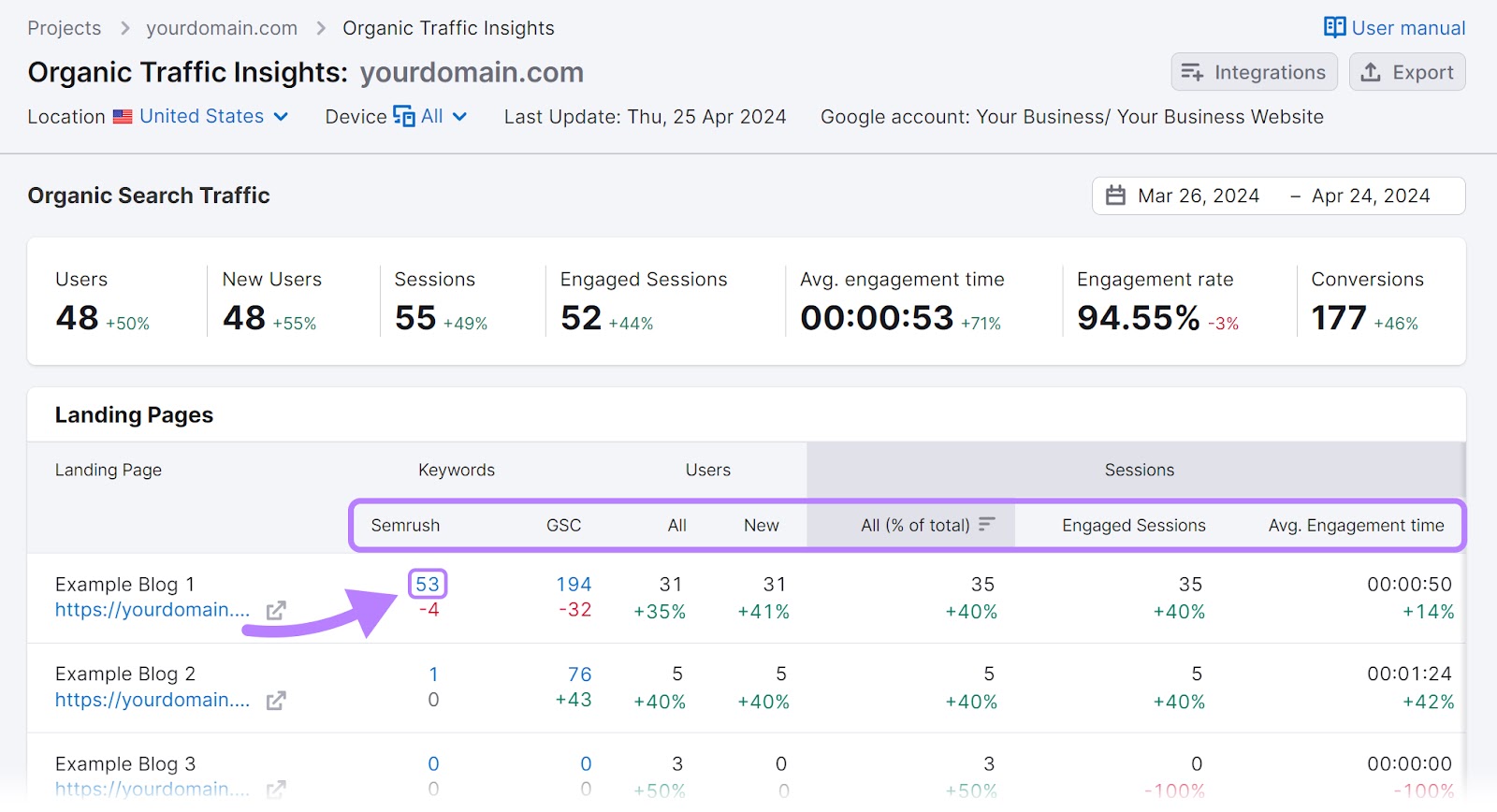
You’ll see information about the keywords driving traffic to that page. Including ranking position and traffic share.
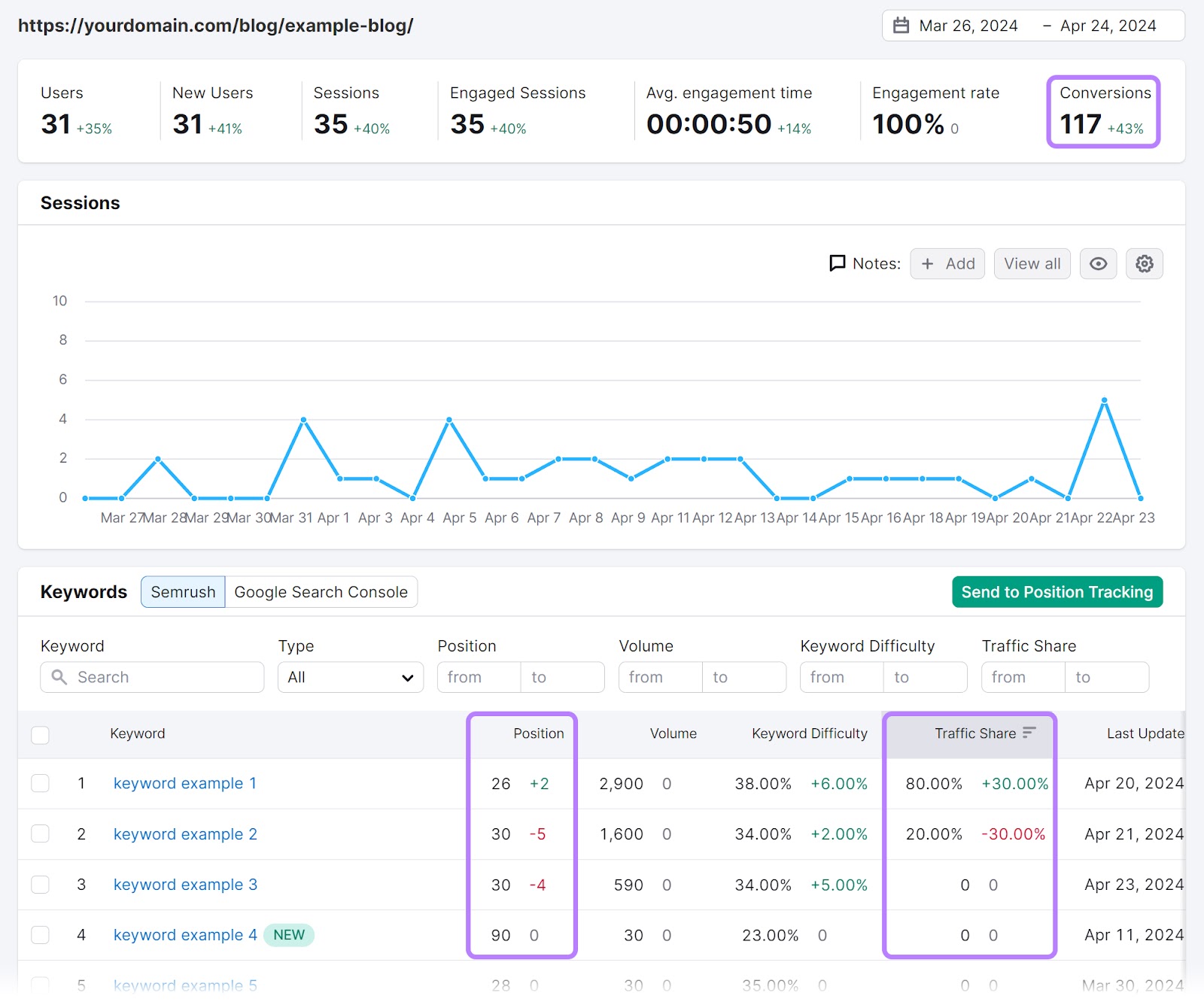
You can use this data to assess your SEO strategy. To understand which keywords are driving the most conversions. And which pages you need to update to improve their performance.
2. Windsor.ai
Windsor.ai is a marketing attribution software tool that supports a variety of single-touch and multi-touch attribution models.
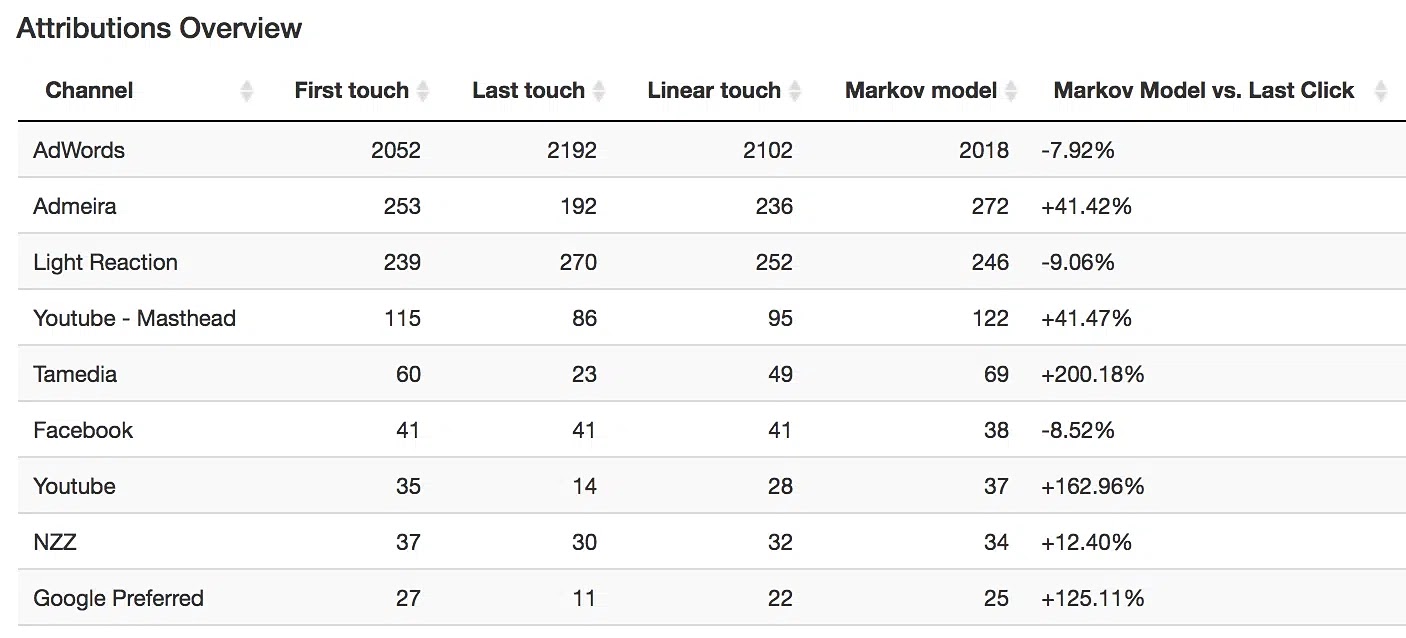
Image Source: Windsor.ai
It’s designed to help businesses measure the return on investment across all their marketing channels.
The software integrates with popular marketing data sources, including ad platforms, analytics software, CRM tools, and ecommerce platforms.
3. Dreamdata
Dreamdata is a marketing attribution solution aimed at B2B marketing teams.
It allows teams to determine their marketing ROI and analyze the customer journey from start to finish.
The software works by collecting data from the tools in your marketing tech stack. And then models the data to connect it to business outcomes.
You can use Dreamdata to see a step-by-step timeline of the customer journey of each individual contact. And compare the performance of different marketing channels in a single report.
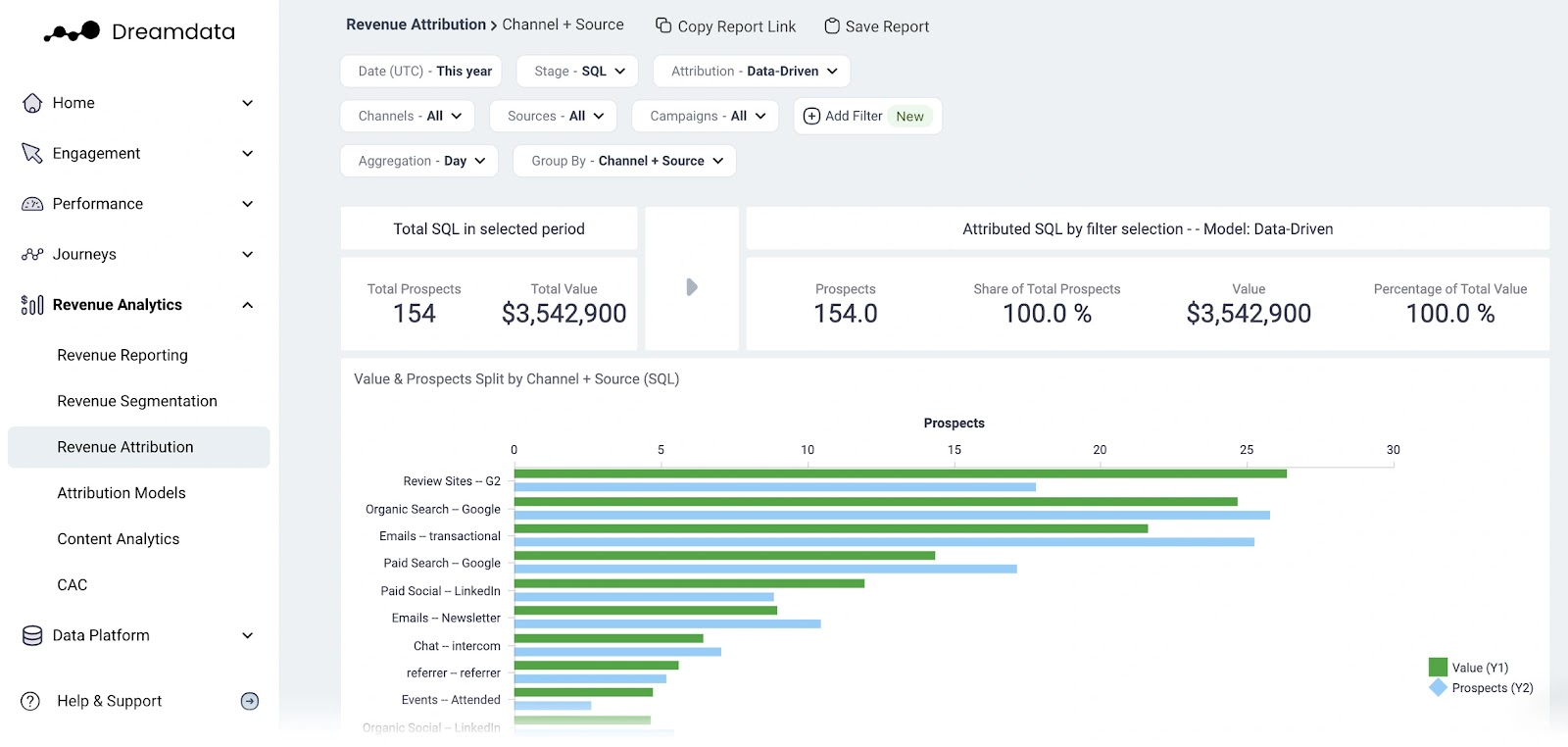
Image Source: Dreamdata
The platform integrates with solutions like Google Search Console, Facebook Ads, Google Ads, Salesforce, and more.
4. Woopra
Woopra helps businesses track and analyze the entire customer journey.
It lets you easily configure custom reports to answer any question you might have about your brand’s marketing performance.
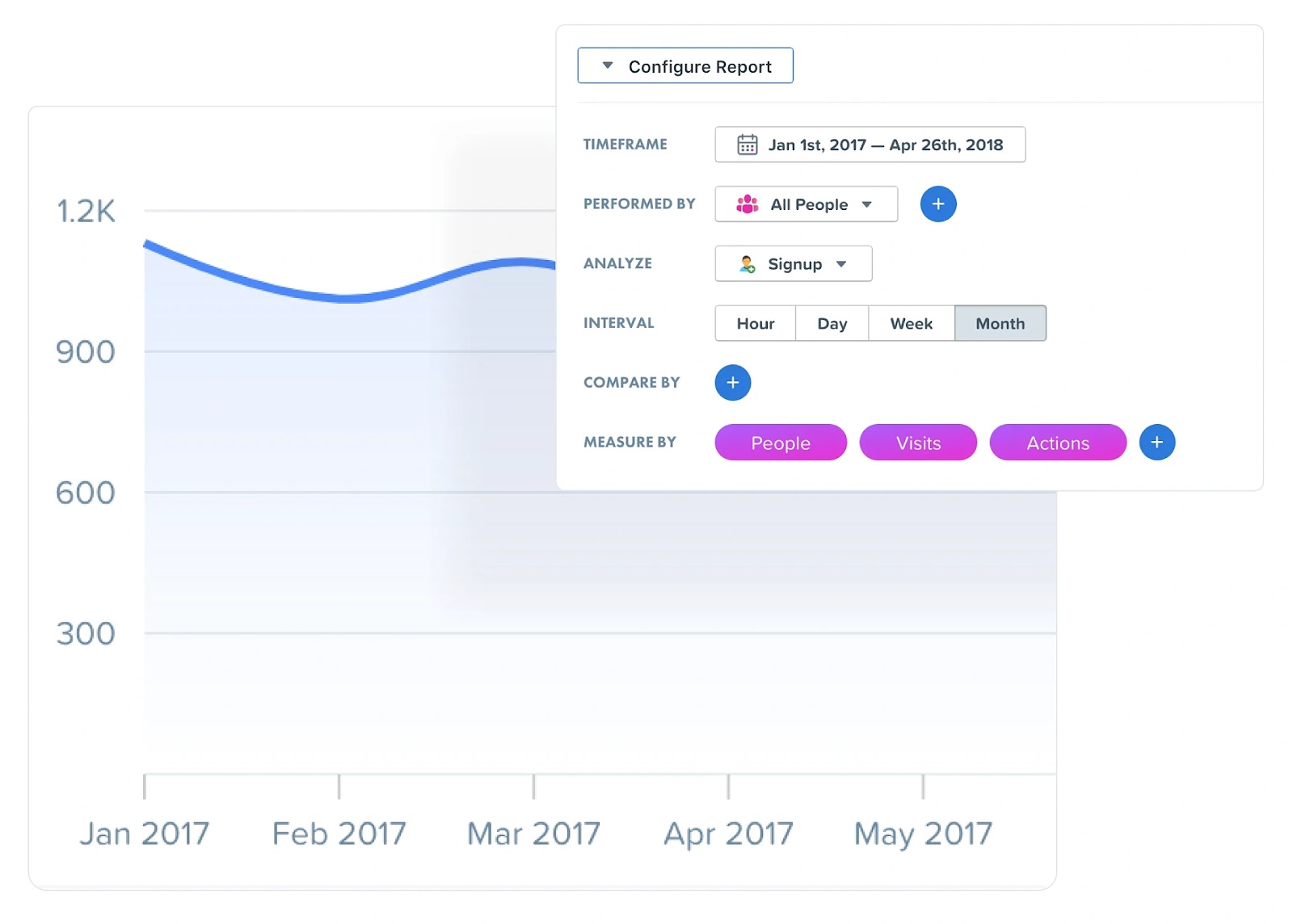
Image Source: Woopra
There’s also the “People Profiles” feature, which lets you examine each contact and how they’re interacting with your brand over time. This gives you data you can use to personalize your customers’ experiences.
Woopra integrates with 50+ popular marketing tools and ad platforms, including Google Ads, Customer.io, and Mailchimp. Allowing for marketing attribution modeling across various channels, like paid ads and email marketing.
5. Ruler Analytics
Ruler Analytics allows you to track the customer journey across all touchpoints. And find out which marketing channels drive the most revenue for your business.
It integrates marketing and sales data to give you a complete overview of your revenue activities.
The software supports tracking clicks, form submissions, and live chat sessions. It’s also capable of tracking offline touchpoints, such as phone calls and store visits.
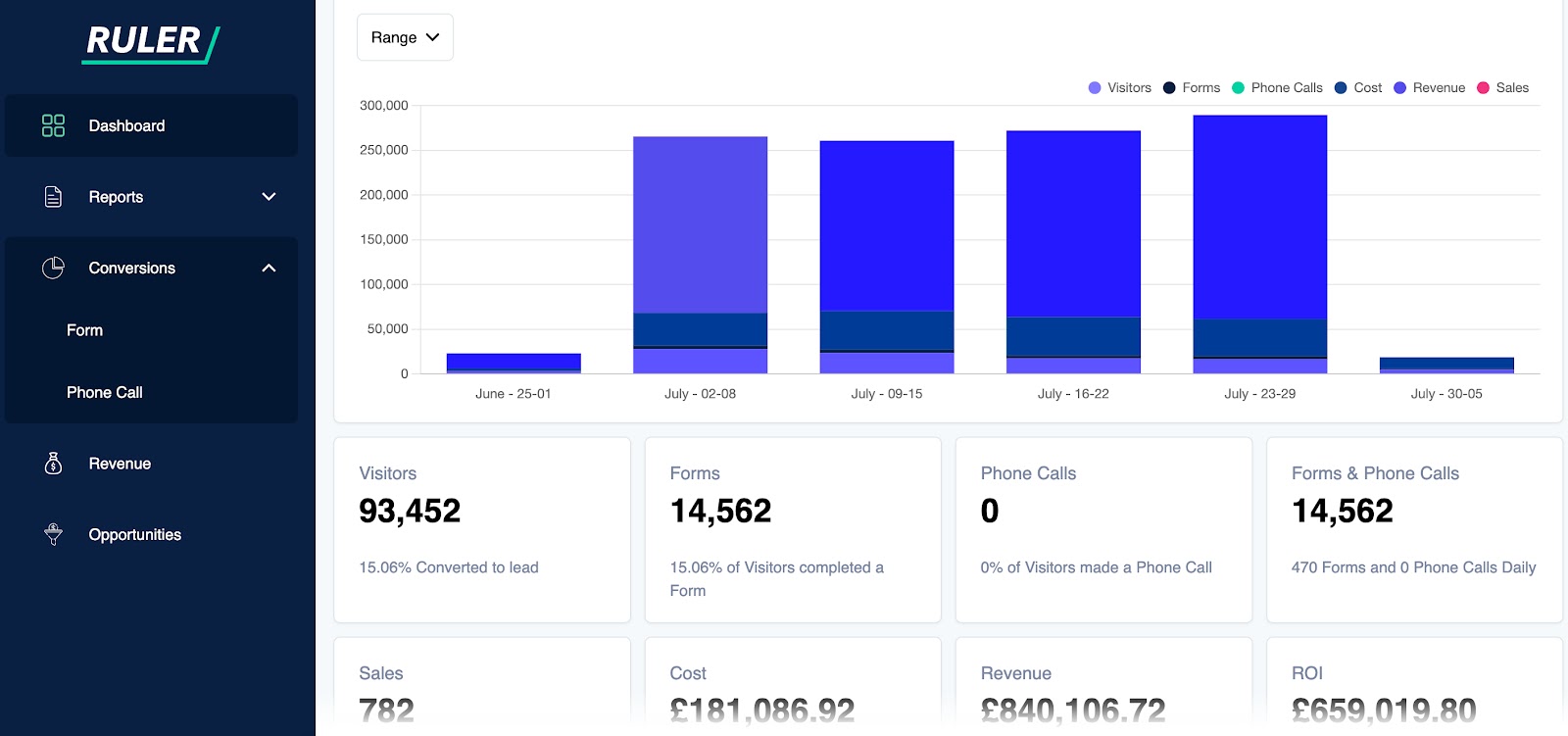
Image Source: G2
Ruler Analytics lets you easily switch between different attribution models within reports. Allowing you to see at a glance how different models might impact your decision-making.
Streamline Your Marketing Attribution Efforts
Implementing a proper marketing attribution process is crucial for increasing the return on your marketing investment. The data you can access through these best practices can allow you to make data-driven decisions.
Decisions that drive real results.
Tools can help you identify marketing opportunities. And double down on the channels that generate the most conversions. Like Semrush’s range of 55+ tools, including:
- Keyword Magic Tool: To help you create content that meets your target audience’s needs
- Organic Traffic Insights: To make it easier to understand which keywords drive the best results
- Advertising Research: To understand your competitors’ ad strategies to enhance your own campaigns
Access these tools and more with a Semrush subscription.
